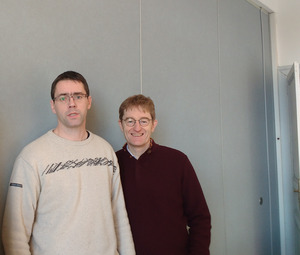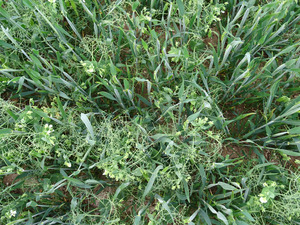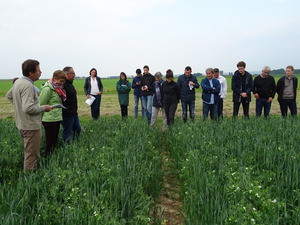Case study 13: France: Introduction of innovative crops and of legumes to foster the sustainability of arable systems under oceanic climate
Cluster 3: Crop diversification in systems from Western Europe
The emergence of sustainable farms requires a shift towards new production systems which are based on ecological intensification, adapted to local conditions, and manageable by farmers. The objectives of this case study are: i) to produce references, knowledge and tools and ii) to promote innovations in arable crop production which mobilize farmers and stakeholders to address local challenges regarding mineral nitrogen dependence, greenhouse gas (GHG) emissions, and carbon footprints.



What were the main problems underlying the emergence of the case study?
Workshops lead by the Syppre inter-institute group (Arvalis, Terres Inovia, ITB) and Terrasolis, stressed several assets and constraints of Champagne’s chalky agricultural area: chalky soils are characterised by limited nitrogen mineralisation potential, by phosphorus soil fixation and low availability, and are exposed to capping and erosion. Maintaining soil fertility is highly dependent on the use of chemical fertilizers, especially nitrogen. In addition to this, regional agriculture is closely linked with local food and non-food industrial plants (such as the sugar and ethanol industry, malting and starch industries) that need quite intensive agriculture to secure their supply. However, corporate clients are more attentive to upstream production specifications. As a result, the environmental impacts and GHG emissions are a weak point of Champagne’s chalky agriculture.
How was the problem addressed and which actors were involved?
During workshops composed of regional experts, stakeholders, and farmers, the method of ‘de novo’ co-design method was applied. Conceived cropping systems had to fulfil the objectives of lowering GHG emissions and mineral fertilizer use, while simultaneously maintaining soil quality and securing the agro-industry supply. Innovative cropping systems from these workshops are implemented on the Syppre and Terrasolis experimental sites, which are located at the Terralab site in the north of Reims City. Terralab is a farm managed by Terrasolis and is cultivated by a group of six farmers.
Building on this first stage, the Terrasolis association initiated a methanisation unit (anaerobic digestion) project to produce biogas on the Terralab site. Methanisation to produce Natural Gas for Vehicles (NGV) is identified as a way to diversify cropping systems, improve economical sustainability and improve the carbon footprint by replacing fossil energy. The unit will be supplied by nearby farms, including Terralab farm.
To complete the approach, Terrasolis will make Terralab an exemplary low carbon footprint farm. The aim is to develop a diversified cropping system that will combine biomass export for NGV production with low direct and indirect GHG emissions.
Our case study can be summarised as follows:
“Prove that diversified cropping systems can supply biomass for methanisation while mitigating GHG emissions at the field scale”.
Solution investigated
During workshops, several levers were chosen to reduce mineral nitrogen use: the introduction of legumes as cover crops; the introduction of low-need crops such as hemp or sunflower; and the implementation of crop associations such as peas + cereals. The carbon footprint will be improved by reducing fuel consumption through minimum tillage. Cover crop or secondary crop biomass can be exported to local methanisation units for energy production. Furthermore, soil cover is a way to protect the soil surface and increase soil stability.
The Syppre and Terrasolis crop systems were previously evaluated using the Systerre tool for multicriteria analysis and performance evaluation. They are now being tested in practice at the Terralab experimental site, making it possible to assess the relevance of levers and their practical feasibility.
A new cropping system has to be designed to match the targets of biomass production and low carbon footprint, while ensuring conventional crop production for regional downstream collection and industry. It will reuse levers which are tested at the experimental site (crop sequences, intercrop management and soil tillage management), but it will have to go further to combining techniques to mitigate GHG emissions. New crop systems will be evaluated using Systerre to determine the multi-criteria performances. Crop system design involves both Terralab’s group of six farmers and the case study team. The case study team relies on results and observations from the experimental sites to exchange with farmers and accompany low carbon system appropriation.
The case study team is now working together with its partners to:
- Organise co-conception workshops to develop proposed cropping systems and evaluate them using the Systerre tool.
- Accompany Terralab farmers when they implement the new crop system on the Terralab farm.
- Obtain farmer feedback and organise farm visits with the Terrasolis farmers involved in the methanisation project in order to raise their interest in low carbon footprint issues and enlarge low carbon territory.
- Follow the global Terrasolis methanisation project in order to identify constraints, successes and sticking points.
Expected outcome
Economic: Methanisation is proposed as a way to improve the economic sustainability of farms by diversifying crops and production. The Terrasolis NGV project should generate a regular income, but it requires an economic plan to account for costs, and a vision of the whole value chain. In the medium term, there will be an issue in monetising low carbon cropping systems.
Technical: Crop systems have to be adapted, taking into account a farm’s specific constraints and with respect to feasibility. Farmers will have to adjust to new crops and new crop management techniques. Reactivity and fast decision making are necessary to deal with unexpected conditions.
Social: The running of the methanisation unit needs organisation between involved farmers. It means new tasks and new knowledge need to be shared among the group. Its establishment implies encouragement of local citizen acceptance and specific communication has to be emphasised, for which a low carbon footprint should be an argument.
Relevance to the DiverIMPACTS goals
Case study 13 deals with non-food crop diversification, which aims to develop a methanisation unit involving 11 farmers. The case study team is following the whole project from its beginning. The case study team has a particular focus on the six farmers cultivating the Terralab farm, whose objective is to go further than only producing biomass for methanisation and reach a low carbon footprint for the farm. The case study team is working with farmers to co-design a specific cropping system and support its implementation on the farm. The case study aim is also to compare that specific system to the ones that are applied on the other farms of the methanisation consortium and see how low carbon territory could be enlarged to the whole methanisation supply area.
Further information
Case study team
- Rémy Duval, ITB (ACTA), case study monitor
- Pascal Amette, ITB (ACTA), case study leader
- Gaël Ponsardin, Marne Agricultural chamber and Terrasolis, case study co-leader
Partnership and associated projects:
Terrasolis (http://terrasolis.fr/) is an association initiated by Grand-Est regional agriculture chamber to promote and develop regional agriculture multi-functionality.
Terralab (https://terralab.fr/) is a farm led by Terrasolis and dedicated to implementing full scale multifunctional agriculture.
Syppre (https://syppre.fr/) is a project of three field crop technical institutes set up to encourage farmers to shift towards sustainable agriculture.
 tap and then scroll down to the Add to Home Screen command.
tap and then scroll down to the Add to Home Screen command.